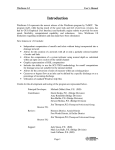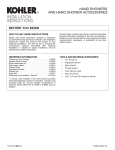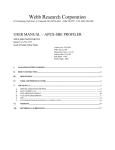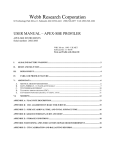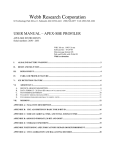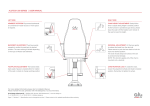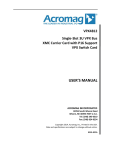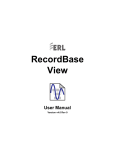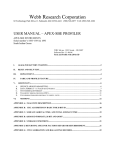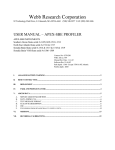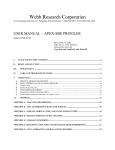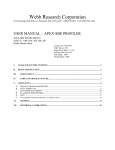Download Torque Control Instruction Manual Book.book
Transcript
ASD TORQUE CONTROL MANUAL ASD Torque Control Manual Document Number: 58696-000 Date: May, 2008 Introduction The ASD Torque Control Manual explains the concepts behind torque control and details the relevant parameter settings for using the Toshiba 9-Series ASD in torque control mode. Please read the entire manual carefully before attempting to operate your ASD in torque control mode. Contact your Toshiba sales representative for additional information. Important Notice The instructions contained in this manual are not intended to cover all details or variations in equipment types. Nor may it provide for every possible contingency concerning the installation, operation, or maintenance of this equipment. Contact your Toshiba sales representative for additional information. The contents of this manual shall not become a part of or modify any prior or existing agreement, commitment, or relationship. The sales contract contains the entire obligation of Toshiba International Corporation. The warranty contained in the contract between the parties is the sole warranty of Toshiba International Corporation and any statements contained herein do not create new warranties or modify the existing warranty. Any electrical or mechanical modifications to this equipment without prior written consent of Toshiba International Corporation will void all warranties and may void other safety certifications. Unauthorized modifications may also result in a safety hazard or equipment damage. Misuse of this equipment could result in injury and equipment damage. In no event will Toshiba Corporation be responsible or liable for direct, indirect, special, or consequential damage or injury that may result from the misuse of this equipment. Contacting Toshiba’s Customer Support Center Toshiba’s Customer Support Center can be contacted to obtain help in resolving any Adjustable Speed Drive system problem that you may experience or to provide application information. The center is open from 8 a.m. to 5 p.m. (CST), Monday through Friday. The Support Center’s toll free number is US (800) 231-1412/Fax (713) 937-9349 — Canada (800) 527-1204. You may also contact Toshiba by writing to: Toshiba International Corporation 13131 West Little York Road Houston, Texas 77041-9990 Attn: ASD Product Manager. For further information on Toshiba’s products and services, please visit our website at www.toshiba.com/ind/. About This Manual This manual was written by the Toshiba Technical Publications Group. This group is tasked with providing technical documentation for the ASD Torque Control Manual. Every effort has been made to provide accurate and concise information to you, our customer. At Toshiba we’re continuously searching for better ways to meet the constantly changing needs of our customers. E-mail your comments, questions, or concerns about this publication to [email protected]. Manual’s Purpose and Scope This manual provides information on how to safely implement Torque Control with the ASD. The information provided in this manual is applicable to ASD Torque Control only. This manual provides configuration information for controlling the ASD via Torque Control. Because of our commitment to continuous improvement, Toshiba International Corporation reserves the right, without prior notice, to update information, make product changes, or to discontinue any product or service identified in this publication. Toshiba International Corporation (TIC) shall not be liable for direct, indirect, special, or consequential damages resulting from the use of the information contained within this manual. TOSHIBA is a registered trademark of Toshiba Corporation. All other product or trade references appearing in this manual are registered trademarks of their respective owners. This manual is copyrighted. No part of this manual may be photocopied or reproduced in any form without the prior written consent of Toshiba International Corporation. © Copyright 2008 Toshiba International Corporation. All rights reserved. Printed in the U.S.A. Table of Contents Torque versus Speed Control ........................................................................................... 1 Torque Control Parameter Settings ................................................................................ 1 V/f Pattern Selection .................................................................................................... 2 Torque Control Selection ............................................................................................. 2 Torque Control Mode Speed Limits ................................................................................ 5 Setting Motor Constants............................................................................................... 7 Torque Control Applications............................................................................................ 9 Unidirectional Rotation ................................................................................................ 9 Bidirectional Rotation ................................................................................................ 11 Summary: Torque Control Parameters ........................................................................ 12 Parameter Descriptions .............................................................................................. 14 ASD Torque Control Manual i ii ASD Torque Control Manual Torque versus Speed Control The Toshiba ASD can be configured to operate in either speed control or torque control mode. Speed control mode detects variance from a reference frequency, and adjusts the ASD output frequency and voltage to match the measured frequency to the reference frequency. ASD M Speed command Torque control mode detects variance from a referenced motor load, and adjusts the output frequency and voltage to match the measured load to the reference load. Torque control of a motor is done in order to maintain a constant tension (load) on a motor. Examples using torque control mode are accelerating/decelerating an elevator or running a winding machine. The ASD can be set for either unidirectional or bidirectional motor rotation as required by the application. ASD M Torque command The ASD can be configured to use either of two torque control methods: • Sensorless vector control relies on the internal programming of ASD. • Vector control with sensor requires the ASD be equipped with one of the encoder feedback options (Toshiba Part No. VEC004Z through 007Z). For applications requiring very accurate torque control use the vector control with sensor method. Set parameter F015 to 8: PG Vector Feedback Control (Speed/Torque). Torque Control Parameter Settings Use the following parameters to configure and operate the ASD in torque control mode. • F015 — V/f pattern • F111 to F118 — Input terminal function selection (use one of them) • F420 — Torque command selection ASD Torque Control Manual 1 V/f Pattern Selection Set parameter F015 – V/f Pattern for torque control by selecting one of two options: • Set F015 to 4: Sensorless Vector Control if not using a motor frequency feedback sensor. • Set F015 to 8: PG Vector Feedback Control if using a motor frequency feedback sensor. Table 1. Parameter F015 selection options. Parameter Function Adjustment range Default setting 0: Constant torque characteristics 1: Square reduction torque control characteristics 2: Automatic torque boost 3: Sensorless vector control (Speed) F015 V/f control mode selection 4: Sensorless vector control (Speed/Torque)1, 3 0: Constant torque characteristics 5: V/f 5-point setting 6: PM control 7: PG feedback vector control (Speed) 8: PG feedback vector control (Speed/Torque)1, 2 1 – Torque control (vector control) requires setting motor-related constants F014, F405 – F407 and F409. Refer to Setting Motor Constants on pg. 7 and motor constants in the ASD instruction manual. 2 – Use two-phase input type sensor when torque control is operated in vector control with sensor mode. 3 – Use vector control with a two-phase sensor for applications requiring “forward power running ↔ reverse regeneration,” and “forward regeneration ↔ reverse power running.” Sensorless vector control does not support these functions. Torque Control Selection Torque control selection can be made by any of the following methods: • Discrete input terminal signal • Parameter commands via the EOI (Electronic Operator Interface) • Communication via DeviceNet, PROFIBUS, etc. Torque Control Selection with Discrete Input Terminal Signal This method assigns the torque control switching signal to an ASD discrete input terminal. Switch between torque control and speed control by closing or opening the switch. The default factory setting for parameter F117 – Input terminal 7 (S3) selection is input setting 14: Preset Speed Command 3. 2 ASD Torque Control Manual To use S3 for control switching, change parameter F117 – Input terminal 7 (S3) selection input setting to 112: Control switching (speed/torque). Parameter Function F117 Input terminal function selection 7(S3) Note: Adjustment range Setting 0 to 135 112: Control switching (speed/torque) If the S3 terminal is already in use, assign the function to an unused discrete input terminal. The terminal function can be set to always-torque by setting parameter F110 – Always ON to 112: Control Switching. Figure 1. Control Switching. Speed Control Torque Control M S3: Control Switching S3: Control Switching RR RR CCA Control switching Speed command M CCA CC OFF between S3-CC RR-CCA (Default Setting) Control switching Torque command CC ON between S3-CC RX-CCA (Default Setting) Table 2. Command Set with F420 Enabled (Default setting: RX input). Parameter F420 Function Torque command selection Note: Adjustment range 1: V/I (voltage/current input) 2: RR (Potentiometer/voltage input) 3: RX (voltage input) 4: Keypad input1 5: RS485 2-wire 6: RS485 4-wire 7: Communications option board 8: RX2/AI1 (differential current input) Default setting 3: RX (voltage input) Select 4: Keypad input to activate the control panel torque reference F725. ASD Torque Control Manual 3 Figure 2. Three control modes. 1.) Current signal 4 – 20 mA mA DC V/I input F108 (analog input V/I current/voltage switching) = 1 (current input) Arbitrary Setting Default Setting F206 = 100% Motor Torque Motor Torque F206 F205 F205 = 0% 4 mA 20 mA F201 = 20% F203 = 100% * Torque produced: 0% at 4 mA DC, and 100% at 20 mA DC. F201 F203 The relationship between the torque command and the motor torque can be changed: F201 and F203 settings 20% and 80% correspond to currents of 8 and 16 mA DC, respectively. 2) Voltage signal 0 – 10 Vdc using RR input. Arbitrary Setting Default Setting F215 = 100% Motor Torque F215 Motor Torque F214 F214 = 0% 0V F210 = 0% 10 V F212 = 100% * Torque produced: 0% at 0 V DC, and 100% at 10 V DC. 4 F210 F212 The relationship between the torque command and the motor torque can be changed: F210 and F212 settings 20% and 70% correspond to voltages of 2 and 7 V DC, respectively. ASD Torque Control Manual Figure 2. Three control modes. (Continued) 3) Voltage signal 0 to ±10 Vdc at RX input Arbitrary Setting Default Setting Torque produced by motor F221 = +150% Torque produced by motor F221 F220 -10 V F220 = 0% 0V F216 = 0% -10 V +10 V F218 = 100% 0V +10 V F216 F218 Torque command Torque command -150% * Torque produced: -150% at -10 V DC, 0% at 0 V DC, and 150% at 10 V DC. The relationship between the torque command and the motor torque can be changed: F216 and F218 settings for 20% and 80% correspond to 2 and 8 V DC, respectively. Torque Control Mode Speed Limits Speed limit parameters limit the rise in the output frequency of the ASD due to a drop in load torque when operating in torque control mode. Speed limits can be set either at a specific frequency, or by specifying a center frequency with a ± frequency bandwidth. Set Speed Limits with External Input Signals Figure 3. Torque Reference Set by an External Potentiometer. Torque reference set by an external potentiometer Torque command (Motor torque) Load torque Torque produced by motor Forward speed limit level Speed Coast Stop Reverse speed limit level Speed varies according to the load torque ASD Torque Control Manual 5 Set Speed Limits with EOI (Electronic Operator Interface) The speed limits can be set by entering the forward/reverse speed limit level parameters F426/F428. Set Forward Speed Limit Level: F425 – Forward Speed Limit Input selection: Set to 4: F426 setting. F426 – Forward Speed Limit Input Level: Set desired forward speed limit level. Set Reverse Speed Limit Level: F427 – Reverse Speed Limit Input selection: Set to 4: F428 setting. F428 – Reverse Speed Limit Input level: Set desired reverse speed limit level. Figure 4. Torque Reference Set with the Operator Interface. Forward speed limit level F426 Speed Coast Stop Reverse speed limit level F428 Speed varies according to the load torque Set Speed Limits with External Signal Speed limits can be adjusted by changing the selected external signals. F425 – Forward Speed Limit Input and F427 – Reverse Speed Limit Input are used to enable/disable setting the speed limit input with either an external discrete input or an internal preset value. Table 3. External Signals. Control signals Voltage signals Current signals Disabled F426/F428 Setting 6 External Input Signal Range F425/F427 Settings RR-CC 0 to 10 V 2: RR RX-CC 0 to ±10 V 3: RX V/I-CC 0 to 10 V 1: V/I V/I-CC 4(0) to 20 mA 1: V/I – – 0: Disabled None 0.0 Hz – F012 4: F426 Setting/4: F428 Setting ASD Torque Control Manual Set Speed Limit using a Center Value and Limit Band A speed limit can be set by entering the center value speed limit and speed limit band. Table 4. Parameters for Speed Limit With the Center Value Specified by a Reference. Parameter Function Adjustment range Default setting F430 Speed limit (torque = 0) center value reference 0: Disabled 1: V/I (voltage/current input) 2: RR (potentiometer/voltage input) 3: RX (voltage input) 4: F431 enabled F431 Speed limit (torque = 0) center value 0.0 Hz to F011 0.0 F432 Speed limit (torque = 0) band 0.0 Hz to F011 0.0 0: Disabled Figure 5. Speed limit set with center value and limit band. Speed limit F011 – Maximum speed limit F431 – Speed limit center value reference F432 – ± Speed limit band Master speed command Speed limits can be adjusted by changing the external signals and by specifying the center reference value. Setting Motor Constants For greatest accuracy in torque control mode several motor parameters need to be recorded in the ASD. These parameters can be entered manually, calculated from basic motor nameplate data, or loaded automatically from pre-programmed Toshiba four-pole motor data. The flow-chart on page 8 shows how to ensure the necessary parameters are recorded in the ASD memory. ASD Torque Control Manual 7 V/f control mode F015 = 4 or 8 Setting Motor Constants with Autotune This flowchart shows the procedure for setting up a motor and running autotune (if necessary) to establish the parameters for high accuracy in torque control mode. Note 1 Is motor a Toshiba standard 4-pole motor with the same capacity as the ASD? See Note 1 YES End NO Set the following parameters as specified on the motor nameplate: Parameter Parameter Range Base frequency Nameplate Information F014 0.0 – 299.0 Hz Base frequency voltage F409 50.0 – 660.0 V Rated capacity of motor F405 0.1 – 500.0 kW Motor rated current F406 0.1 – 2000 A Motor rated speed F407 100 – 60,000 rpm Note 2 Set F400 = 4 (After execution, the setting resets to F400 = 0) See Note 2 Note 3 Etn 3 (Autotune Error 3) displayed? NO Motor connected and in a standby state? See Note 3 NO YES YES F014 (base frequency) or F407 (rated rotational speed) of the motor is not set correctly. Check the precautions to be taken when setting F400 = 1; if not problem, then set F400 = 2 and begin operation Make necessary settings as specified in (1) Setting auto-tuning End Enter F014 (base frequency) or F407 (rated rotational speed) and set F400 = 4 again. YES Etn 1 (Autotune error 1) or Etn 2 (Autotune error 2) displayed? NO The following parameters have been calculated and set: F410 – Motor Constant 1 (Torque boost) F411 – Motor Constant 2 (No-load current) F412 – Motor Constant 3 (Leak inductance) F413 – Motor Constant 4 (Rated slip) F410 and F412 have been tuned to the connected motor F410 and F412 use the value calculated by the ASD End End Note 1: Motor used Type Toshiba standard motor No. Motor Poles 4-Pole Other than 4-Pole Tuning required: Yes/No Capacity Same as ASD No (Tuned to factory defaults)* Different than ASD Same as ASD Different than ASD Yes Others * When using motor cables 100 ft. (30 m) or longer, set F400 (Autotune 1) = 2. Note 2: Motor does not need to be connected. Note 3: Motor is connected but can be loaded or unloaded. 8 ASD Torque Control Manual Torque Control Applications Unidirectional Rotation If a motor rotates in one direction and does not reverse rotation during operation, set F435 – Rotation in Specified Direction ONLY to 1: Enabled. The direction of rotation of the motor is set by parameter F008 – Forward/Reverse Run Selection. Set F008 to 0: Forward, or 1: Reverse, as required by the system. See the ASD Operation Manual for details of the interaction between F008 – Forward/Reverse Run Selection and F311 – Forward Run/Reverse Run Disable. On a paper manufacturing line for example, once the machines have been set up the direction of rotation of their motors is fixed and does not change. When controlling the operation of the entire system, the torque produced in the desired direction of rotation (direction specified by a rotation command) is considered positive torque and the torque produced opposite of the specified rotation is considered negative torque. In Figure 7. on pg. 10 motors ASD 1 and 2 drive rolls that rotate to send material in one direction along the manufacturing line. The direction of rotation of ASD 1 and 2 differ depending on whether they are placed on the top or bottom side of the line they drive. In this case ASD 1 rotates forward, and ASD 2 rotates in reverse. Torque commands from the host control unit of the system to the ASDs have unified polarity and the direction of rotation of each individual motor is ignored. That is why this setting is usually used for systems that use motors whose directions of rotation remain unchanged. Figure 6. Unidirectional rotation: F435 – Enabled. Forward run command enabled (F) Reverse run command enabled (R) Region 3 F441: Power running torque limit Region 1 Forward run Region 4 Negative torque Positive torque ASD Torque Control Manual Same torque command Region 2 Reverse run F441: Power running torque limit Positive torque Negative torque F443: Regenerative braking torque limit F443: Regenerative braking torque limit 9 Figure 7. Example of Unidirectional Torque Control. In this system the product is sent in a fixed direction. The direction of rotation of each motor is determined by the command (F or R) from the ASD, regardless of the operating status: power running or regenerative braking. Reverse run Note: In actual practice torque control is not necessarily performed on all rollers. M M M ASD ASD ASD 1 F: Forward run Torque control performed by ASD 1 2 R: Reverse run Torque control performed by ASD 2 Direction of force Rotational direction = Direction specified by command = Forward run Status: Forward/Regenerative Region: 4 3 F: Forward run Torque control performed by ASD 3 Direction of force Direction of force 10 Forward run Rotational direction = Direction specified by command = Reverse run Status: Reverse run/ Regenerative torque. Region: 2 Direction of force Rotational direction = Direction specified by command = Reverse run Status: Reverse run/Power running torque. Region: 3 Rotational direction = Direction specified by command = Forward run Status: Forward run/Power running torque Region: 1 ASD Torque Control Manual Bidirectional Rotation If the direction of rotation of a motor changes while the direction in which the load is applied does not, set parameter F435 – Rotation In Specified Direction ONLY to 0 – Disabled. This disables processing of the settings in F311 – Forward Run/ Reverse Run Disable. Cranes and elevator motors are subjected to the kind of loading resulting in bidirectional rotation. Figure 8. Bidirectional rotaton: F435 – Disabled. Positive torque Torque command (Forward/reverse run in succession) F441: Power running torque limit Region 2 Region 1 Forward run Reverse run Region 3 Region 4 F443: Regenerative braking torque limit Negative torque This setting is used for controlling a motor whose direction of rotation is determined regardless of the forward or reverse command from the ASD. Figure 9. Example of Bidirectional Torque Control. In the system shown here the direction of rotation of the motor, its operating status, will change between power running and regenerative braking according to the process demands. ASD Torque Control Manual Torque command > Load torque Rotating direction Direction of force Torque command < Load torque Rotating direction Direction of force ASD direction specified by command ASD direction specified by command Rotational Direction = Forward Run ASD direction specified by Command= Forward Run/ Positive Torque (Power running) Rotational Direction = Reverse Run ASD direction specified by Command= Reverse Run/ Positive Torque (Regenerative) 11 Summary: Torque Control Parameters Below is a summary of torque control and related parameters. Table 5. Torque Control and Related Parameters. Parameter Number F004 12 Parameter Name Adjustment Range Default Setting Frequency Mode 1 1: V/I 2: RR 3: RX 4: Not Used 5: EOI Keypad 6: RS485 7: Communications Option Board 8: RX2 (AI1) 9: Option V/I 10: UP/DOWN Frequency (terminal board) 11: Pulse Input (option) 12: Pulse Input (motor CPU) 13: Binary/BCD Input (option) 2: RR F011 Maximum Frequency 30.0 – 299.0 Hz 80.0 F012 Upper Limit Frequency 0.0 Hz – F011 60.0 F013 Lower Limit Frequency 0.0 Hz – F012 0.0 F014 Base Frequency 1 0.0 Hz – F012 60.0 F015 V/f Pattern 0: Constant Torque 1: Voltage Decrease Curve 2: Automatic Torque Boost 3: Sensorless Vector Control (Speed) 4: Sensorless Vector Control (Speed/Torque) 5: V/f 5-Point Curve 6: PM Drive 7: PG Feedback Vector Control (Speed) 8: PG Feedback Vector Control (Speed/ Torque) F201 V/I Input Point 1 Setting 0 – 100% 0 F203 V/I Input Point 2 Setting 0 – 100% 100 F205 V/I Input Point 1 Rate 0 – 250% 0 F206 V/I Input Point 2 Rate 0 – 250% 100 F207 Frequency Mode 2 Same as F004 (1 – 13) F210 RR Input Point 1 Setting 0 – 100% 0 F212 RR Input Point 2 Setting 0 – 100% 100 F214 RR Input Point 1 Rate 0 – 250% 0 F215 RR Input Point 2 Rate 0 – 250% 100 F216 RX Input Point 1 Setting ±100% 0 F218 RX Input Point 2 Setting ±100% 100 F220 RX Input Point 2 Rate ±250% 0 F221 RX Input Point 2 Rate ±250% 100 F222 RX2 Input Point 1 Setting ±100% 0 F224 RX2 Input Point 2 Setting ±100% 100 F226 RX2 Input Point 2 Rate ±250% 0.0 0: Constant Torque 1 ASD Torque Control Manual Parameter Number F227 Parameter Name Adjustment Range Default Setting RX2 Input Point 2 Rate ±250% Forward Run/Reverse Run Disable 0: Off 1: Disable Reverse Run 2: Disable Forward Run F400 Autotuning 1 0: Autotune Disabled 1: Reset Motor Defaults 2: Enable Autotune on Run Command 3: Autotuning by Input Terminal Signal 4: Motor Constant Auto-calculation F405 Motor Rated Capacity 0.1 – 500.0 hp F406 Motor Rated Current 0.1 – 2000.0 A 20.3 F407 Motor Rated RPM 100 – 60,000 RPM 1730 F409 Base Frequency Voltage 1 50.0 – 660.0 V ASD Dependant F410 Motor Constant 1 (Torque Boost) 0.0 – 30.0% ASD Dependant F411 Motor Constant2 (No-load Current) 10 – 90% ASD Dependant F412 Motor Constant3 (Leak Inductance) 0 – 200% ASD Dependant F413 Motor Constant 4 (Rated Slip) 0.01 – 25.00% ASD Dependant Torque Command Selection 1: V/I 2: RR 3: RX 4: Panel Keypad 5: RD482 2-Wire 6: RS482 4-Wire 7: Communication Option board 8: RX2 (AI1) F425 Forward Speed Limit Input 0: Disabled 1: V/I 2: RR 3: RX 4: F426 F426 Forward Speed Limit Level 0.0 Hz – F012 F427 Reverse Speed Limit Input 0: Disabled 1: V/I 2: RR 3: RX 4: F426 F428 Reverse Speed Limit Level 0.0 Hz – F012 80.0 F430 Speed Limit Center Value Reference 0: Disabled 1: V/I 2: RR 3: RX 4: F431Setting 0: Disabled F431 Speed Limit Center Value 0.0 Hz – F011 0.0 F432 Speed Limit Band 0.0 Hz – F011 0.0 F435 Rotation in Specified Direction Only 0: Disabled 1: Enabled Power Running Torque Limit 1 1: V/I 2: RR 3: RX 4: F441 Setting F311 F420 F440 ASD Torque Control Manual 100 0: Off 0: Autotune Disabled 11.0 3: RX 0: Disabled 80.0 0: Disabled 0: Disabled 4: F441 13 Parameter Number Parameter Name F441 Power Running Torque Limit 1 Level 0.0 – 249.9% 250 (Disabled) 250 (Disabled) F442 Regenerative Braking Torque Limit 1 1: V/I 2: RR 3: RX 4: F443 Setting 4: F443 F443 Regenerative Braking Torque Limit 1 Level 0.0 – 249.9% 250 (Disabled) 250 (Disabled) F444 Power Running Torque Limit 2 Level 0.0 – 249.9% 250 (Disabled) 250 (Disabled) F445 Regenerative Braking Torque Limit 2 Level 0.0 – 249.9% 250 (Disabled) 250 (Disabled) F446 Power Running Torque Limit 3 Level 0.0 – 249.9% 250 (Disabled) 250 (Disabled) F447 Regenerative Braking Torque Limit 3 Level 0.0 – 249.9% 250 (Disabled) 250 (Disabled) F448 Power Running Torque Limit 4 Level 0.0 – 249.9% 250 (Disabled) 250 (Disabled) F449 Regenerative Braking Torque Limit 4 Level 0.0 – 249.9% 250 (Disabled) 250 (Disabled) F472 RR Input Bias 0 – 255 F473 RR Input Gain 0 – 255 154 F474 RX Input Bias 0 – 255 127 F475 RX Input Gain 0 – 255 127 F476 RX2 Input Bias 0 – 255 128 F477 RX2 Input Gain 0 – 255 128 F725 Panel Torque Command ±250% 0.00 F727 Panel Tension Torque Bias ±250% 0.00 Adjustment Range Default Setting 128 Parameter Descriptions F004 — Frequency Mode 1 specifies the input source for the frequency command. F011 — Maximum Frequency specifies the absolute maximum frequency that the ASD will output. Acceleration/deceleration times are calculated based on this value. F012 — Upper Limit Frequency specifies the highest frequency that the ASD will accept as a frequency command. The ASD may output frequencies higher than Upper Limit Frequency (but no higher than Maximum Frequency) when operating in PID-, Torque-, or Vector Control mode. F013 — Lower Limit Frequency is the lowest frequency that the ASD will accept as a frequency command or set point. Under certain conditions the ASD may output frequencies lower than the Lower Limit Frequency. • • • Accelerating from a stop, Decelerating to a stop, System is in PID-, Torque-, or Vector Control modes F014 — Base Frequency 1 is the frequency at which the output voltage of the ASD reaches its maximum setting. The Base Frequency should be set to the frequency listed on the motor nameplate. F015 — V/f Pattern establishes the relationship between the output frequency and the output voltage. See the ASD manual for details. 14 ASD Torque Control Manual F201, F203 — V/I Input Point 1, 2 Setting sets two points that establish the V/I response slope. The two points typically refer to the lower and upper range limits as a percent of maximum frequency/full-load torque. The use of F201, F203, F205, and F206 is explained in detail in the ASD Operation Manual. F205, F206 — V/I Input Point 1, 2 Rate is used to set the gain and bias of the V/I input terminal when operating in Torque Control Mode. These parameters set the output torque value associated with Input Point Settings as a percent of full-load torque. F207 — Frequency Mode 2 specifies the input source for the frequency command used as Frequency Mode 2. F210, F212 — RR Input Point 1, 2 Setting set the two points that establish the RR response slope. These two settings are entered as a percentage of F011– Maximum Frequency. The use of F210, F212, F214, and F215 is explained in detail in the ASD Operation Manual. F214, F215 — RR Input Point 1, 2 Rate is used to set the gain and bias of the RR input terminal when operating in Torque Control Mode. These parameters set the output torque value associated with Input Point Settings as a percent of full-load torque. F216, F218 — RX Input Point 1, 2 Setting set the two points that establish the RX response slope. These two settings are entered as a percentage of F011– Maximum Frequency. The use of F216, F218, F220, and F221 is explained in detail in the ASD Operation Manual. F220, F221 — RX Input Point 1, 2 Rate is used to set the gain and bias of the RX input terminal when operating in Torque Control Mode. These parameters set the output torque value associated with Input Point Settings as a percent of full-load torque. F222, F224 — RX2 Input Point 1, 2 Setting set the two points that establish the RX2 response slope. These two settings are entered as a percentage of F011– Maximum Frequency. The use of F222, F224, F226, and F227 is explained in detail in the ASD Operation Manual. F226, F227 — RX2 Input Point 1, 2 Rate is used to set the gain and bias of the RX2 input terminal when operating in Torque Control Mode. These parameters set the output torque value associated with Input Point Settings as a percent of full-load torque. F311 — Forward Run/Reverse Run Disable sets the Forward Run or Reverse Run mode. If 0 – Off is selected the received direction command will determine the motor rotation. F400 — Autotuning 1 sets the autotune command status. See the ASD User Manual for details. F405 — Motor Rated Capacity sets the nameplate rated capacity. F406 — Motor Rated Current sets the nameplate rated current. F407 — Motor Rated RPM sets the nameplate rated motor speed. F409 — Base Frequency Voltage 1 is the motor output voltage at F014 – Base Frequency 1. F410 — Motor Constant 1 (Torque Boost) sets the primary resistance of the motor. Increasing this value can prevent a drop in motor torque at low speeds. F411 — Motor Constant 2 (No-load Current) specifies the current lever required to excite the motor. Specifying a value that is too high may result in erratic motor operation. F412 — Motor Constant 3 (Leak Inductance) sets the leakage inductance of the motor. A higher setting results in a higher output torque at high speeds. F413 — Motor Constant 4 (Rated Slip) sets the secondary resistance of the motor. An increase in this parameter results in an increase in compensation for motor slip. F420 — Torque Command Selection in Torque Control mode allows the user to select the source of the torque command signal. F425, F427 — Forward, Reverse Speed Limit Input enables/disables the Forward/Reverse Speed Limit Input control function. When enabled in Torque Control mode, the forward/reverse speed limit is controlled by the selected input. F426, F428 — Forward, Reverse Speed Limit Input Level provides a set value to used as the forward/ reverse speed limit settings if Setting is selected in F425 or F427. ASD Torque Control Manual 15 F430 — Speed Limit Center Value Reference selects the input terminal that be used to control the allowable speed variance. F431 — Speed Limit Center Value sets the target speed in Torque Control mode. F432 — Speed Limit Band establish a plus-or-minus bandwidth for the corresponding Speed Limit Center Value in F431. F435 — Rotation in Specified Direction Only enables or disables the Forward Run or Reverse Run mode. If either direction is disabled, commands for the disabled direction will not be recognized. F440 — Power Running Torque Limit 1 determines the source of the control signal for the positive torque limit settings. If Settings is selected, the value set in F441 is used as the input. F441, F444, F446, F448 — Power Running Torque Limit 1 – 4 Level provides the value of the control signal input for the positive torque upper limit for the #1 – #4 motor profiles if Settings is selected. F442 — Regenerative Braking Torque Limit 1 determines the source of the control signal for the Regenerative Torque Limit settings. If Settings is selected, the value set in F443 is used as the input. F443, F445, F447, F449 — Regenerative Braking Torque Limit 1 – 4 Level provides the value of the control signal input for the Regenerative Torque Limit for the #1 – #4 motor profiles if Settings is selected. F472, F474, F476 — RR/RX/RX2 Input Bias may be used to ensure that the zero level of the input source is also the zero level setting of the ASD system. F473, F475, F477 — RR/RX/RX2 Input Gain may be used to fine tune the gain of the input terminal to ensure that the 100% level of the input source is also the 100% level of the ASD system. F725 — Panel Torque Command sets the torque command when using the LED Keypad option. F727 — Panel Tension Torque Bias sets the torque bias when using the LED Keypad option. 16 ASD Torque Control Manual ASD Torque Control Manual 17 INDUSTRIAL DIVISION 13131 West Little York Road, Houston, Texas 77041 Tel 713/466-0277 Fax 713/937-9349 US 800/231-1412 Canada 800/872-2192 Mexico 01/800/527-1204 www.toshiba.com/ind Printed in the U.S.A.



























